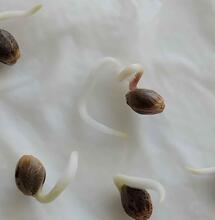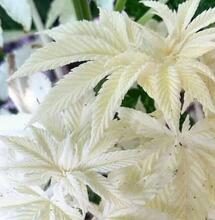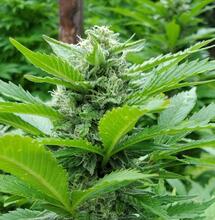The Scoop on Soil

As an herb farmer you need to make an intelligent choice as to what kind of soil you want to grow in. It is often very easy to distinguish the flavor of an organic or naturally grown product over a synthetically fertilized one. That in itself ought to help you understand how important natural soil is. There are a few other reasons to stay away from commercial fertilizers. These inorganic fertilizers are primarily produced from natural gas. This is ultimately unsustainable as they pollute our waters with excessive nitrogen, and destroy both micro fauna and the beneficial effects humus creates in the soil. While the last 60 years has been a boon for agri-business, I'm not sure that as individuals or as a society we benefit that much. Fortunately, we can make an informed choice and we have thousands of years in cumulative knowledge on how to make good soil.
Before we get our hands in the dirt we ought to know what's in it.
A healthy soil is a dynamic system of life. The living components are bacteria, fungi, protozoa, algae, small insects and animals. An acre of land could have two tons of this life in it. A bottle cap of this precious earth may contain upwards of 100,000 protozoa, 30 million fungi and 2 billion bacteria. When these organisms die, enzymes from fungi and bacterial action break down the organic matter and free nutrients into the soil for plant growth.
This process creates humus, a complex polymer that acts like a sponge helping to hold water and minerals. Humus tends to have a negative charge, attracting minerals to it. In this way, it acts as a catalyst in the ion exchange of nutrients through bacteria, aiding absorption into plant roots. Nutrients are necessary for plant life. Some of the following you may remember from chemistry class. The macronutrients are the largest quantities of nutrients plants use.
They are nitrogen, phosphorus and potassium. The secondary macronutrients are calcium, sulfur and magnesium. Some of the micronutrients, also known as trace minerals, are boron, iron and zinc. These are all important for the process of growing, flowering and fruiting. If the individual or groups of these nutrients are missing in your soil, plants will respond in their growth, leaf and stem colors, giving clues as to what is missing.
As a plant grows through its life cycle some of these nutrients are needed more than others. For a plant in its vegetative state nitrogen is important. Nitrogen aids in growth and chlorophyll production. Be careful; more is not always better. Plants with excessive nitrogen in the soil or hydro solutions after harvest will not burn as well and flavors are destroyed by an ashy taste. Nitrogen is less important as the plant begins to flower and more phosphorus and potassium are consumed.
Aggregate is the bulk of what makes up soil. It is what gives soil texture and determines how well water drains through. In nature it can be found in multiple combinations from the microscopic clay particles to the visible silt, fine- and coarse sand, pebbles and rocks. Soil with poor drainage can suffocate your root systems and cause your plants to rot. Proper drainage is essential in any mix of soils.
All these different mixes of soil give various pH readings - the measure of soil acidity or alkalinity. The pH of your soil can affect the ability of your plants to absorb nutrients. Dolomite or limestone is a great addition to help soil maintain a neutral pH. While planting mixes sold at your local store generally have a neutral pH, the ground where you live can vary from highly acidic to alkaline. Test kits and strips are available at many garden centers. Garden centers are also a valuable resource for knowledge on the conditions in your area.
Now that you are familiar with some of what is in the soil (yes!) it is time to get your hands in the dirt and learn some more ways to improve your growth and flowering. Physical appearance of soil is misleading as a gravelly soil can be very productive, which is very evident in hydroponic systems where lava rock or clay pellets are used with nutrients in solution. Soil color can also be misleading and does not equate fertility. A red soil can be as productive as a brown one. Compost is a great way to add life into your soil. It can be as easy as stirring up kitchen scraps into a pile of dirt. Add worms and you have vermicompost. Worms are natural soil builders with dirt castings coming out 10 times richer than going in. These wiggly worms turn brown dirt and decaying matter into black gold.
There are also a great number of natural fertilizers and soil conditioners on the market to improve the quality of your soil. Guanos are excellent sources of natural fertilizers. I have used cricket-, bat- and fish emulsion with great success. Many of these guano fertilizers are good on their own. Some farmers like to boost flowering with phosphorus from bone meal and potassium from green sand in their mix. With a good blend of these in either indoor or outdoor containers a plant can go through its whole cycle without the need for supplemental fertilizer.
If you find you that your soil is depleting faster than anticipated - for instance, if your shade leaves yellow during vegetative growth - you can add a small amount of the guanos into water for additional nutrition. If you have no budget for these or other store-bought items, your local community will be a wealth of resources for composting and making your own fertilizers. Many businesses dispose of excellent materials. Cast-offs from salons, grocery stores, restaurants, breweries and even your neighbor's lawn clippings can be used to produce excellent soil. There is no excuse not to get started. Soil is everywhere to be found. Do it right, the natural way. Stay organic for awesome flavor. Recycle your dirt, compost your kitchen and yard waste. Make your future grow.



